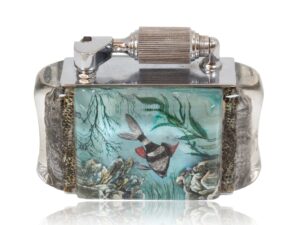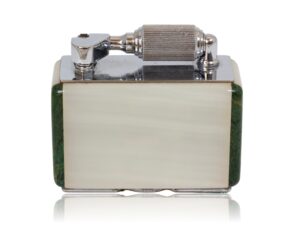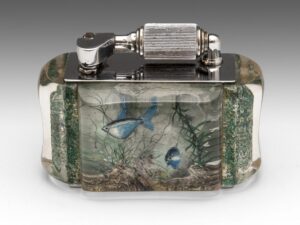McMurdo
McMurdo, a British company, became famous for producing high-quality table lighters in the mid-20th century, primarily during the 1930s and 1940s. McMurdo lighters are now cherished by collectors for their distinctive designs, excellent craftsmanship, and durability. They were especially popular in the UK, where they became iconic fixtures on tables in homes, bars, and clubs.
Key Points About McMurdo Lighters
Founding and Early History:
The McMurdo Company was based in London and rose to prominence as a lighter manufacturer during the 1930s.
Their lighters became known for reliability and style, fitting well into the Art Deco period’s aesthetic with sleek, streamlined designs that combined form and function.
Design and Innovation:
Table Lighters: McMurdo focused on creating table lighters rather than pocket lighters. These lighters were designed to be placed on tables in homes or establishments, rather than carried around. They often had a solid base, giving them a substantial, decorative feel.
Distinctive Mechanisms: McMurdo lighters were admired for their smooth ignition mechanisms, often employing a flint-wheel ignition system that was easy to use and highly dependable.
Stylish and Luxurious Materials: McMurdo lighters were often made with high-quality materials such as chrome, brass, or even silver-plated metal. The finishes were polished and elegant, adding a touch of luxury to any space.
Art Deco Influence:
Many McMurdo lighters reflect the Art Deco style, with geometric shapes, bold lines, and a mix of chrome or lacquer finishes. This design approach was highly fashionable at the time and helped McMurdo’s lighters stand out as both practical tools and decorative pieces.
The company embraced the era’s aesthetic, creating lighters that doubled as art objects, which contributed to their popularity as statement items in homes and businesses.
Durability and Collectibility:
McMurdo lighters were built to last, and their robust construction has contributed to their survival as collectibles. The lighters typically have simple mechanisms that are easy to maintain, so many pieces from the 1930s and 1940s are still functional.
They are now sought-after collectibles, especially among Art Deco enthusiasts and lighter collectors. McMurdo lighters are appreciated for their design quality and historical significance as artifacts from a stylish, modernist period in design history.
McMurdo’s Legacy:
While McMurdo is no longer in business, its lighters remain highly collectible and often appear at antique fairs, auctions, and specialty vintage shops.
The company’s lighters represent an era when smoking accessories were crafted with as much care as jewelry or fine furniture. Today, McMurdo table lighters are admired not only for their function but also as timeless examples of mid-century British design and craftsmanship.
In summary, McMurdo lighters became famous for their blend of style, durability, and craftsmanship. With their Art Deco-inspired designs and robust construction, they are cherished by collectors today as beautiful and functional relics of 20th-century British design.
McMurdo
McMurdo, a British company, became famous for producing high-quality table lighters in the mid-20th century, primarily during the 1930s and 1940s. McMurdo lighters are now cherished by collectors for their distinctive designs, excellent craftsmanship, and durability. They were especially popular in the UK, where they became iconic fixtures on tables in homes, bars, and clubs.
Key Points About McMurdo Lighters
Founding and Early History:
The McMurdo Company was based in London and rose to prominence as a lighter manufacturer during the 1930s.
Their lighters became known for reliability and style, fitting well into the Art Deco period’s aesthetic with sleek, streamlined designs that combined form and function.
Design and Innovation:
Table Lighters: McMurdo focused on creating table lighters rather than pocket lighters. These lighters were designed to be placed on tables in homes or establishments, rather than carried around. They often had a solid base, giving them a substantial, decorative feel.
Distinctive Mechanisms: McMurdo lighters were admired for their smooth ignition mechanisms, often employing a flint-wheel ignition system that was easy to use and highly dependable.
Stylish and Luxurious Materials: McMurdo lighters were often made with high-quality materials such as chrome, brass, or even silver-plated metal. The finishes were polished and elegant, adding a touch of luxury to any space.
Art Deco Influence:
Many McMurdo lighters reflect the Art Deco style, with geometric shapes, bold lines, and a mix of chrome or lacquer finishes. This design approach was highly fashionable at the time and helped McMurdo’s lighters stand out as both practical tools and decorative pieces.
The company embraced the era’s aesthetic, creating lighters that doubled as art objects, which contributed to their popularity as statement items in homes and businesses.
Durability and Collectibility:
McMurdo lighters were built to last, and their robust construction has contributed to their survival as collectibles. The lighters typically have simple mechanisms that are easy to maintain, so many pieces from the 1930s and 1940s are still functional.
They are now sought-after collectibles, especially among Art Deco enthusiasts and lighter collectors. McMurdo lighters are appreciated for their design quality and historical significance as artifacts from a stylish, modernist period in design history.
McMurdo’s Legacy:
While McMurdo is no longer in business, its lighters remain highly collectible and often appear at antique fairs, auctions, and specialty vintage shops.
The company’s lighters represent an era when smoking accessories were crafted with as much care as jewelry or fine furniture. Today, McMurdo table lighters are admired not only for their function but also as timeless examples of mid-century British design and craftsmanship.
In summary, McMurdo lighters became famous for their blend of style, durability, and craftsmanship. With their Art Deco-inspired designs and robust construction, they are cherished by collectors today as beautiful and functional relics of 20th-century British design.
Showing all 4 resultsSorted by latest




